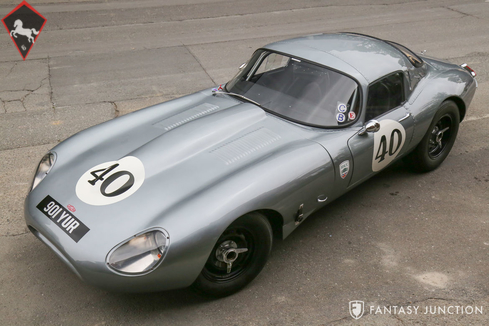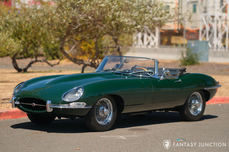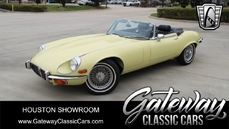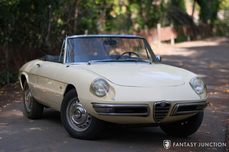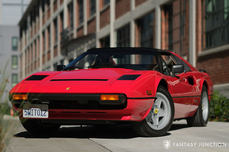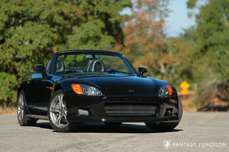Jaguar E-type 3.8L Inline 6-Cylinder Dry Sump 1962
Allgemeine Beschreibung :
1962 Jaguar E-Type Series 1 “Low Drag” Coupe
s/n 887033, Engine No. ZA7747-8
Silver with Black Leather
Consistently ranked today as among the most beautiful sports cars ever conceived, the Jaguar E-Type was simply a revelation of beauty and performance on the day it was unveiled at the 1961 Geneva Motor Show. Brilliantly designed and offering unrivaled race-bred performance, the E-Type became an instant sensation with enthusiasts all over the world. With its beautiful lines and surprisingly affordable price, the E-Type grew to iconic status where it still reigns, continuing to charm new generations of enthusiasts. But it wasn’t beauty alone. Jaguar’s racing experience delivered very progressive performance features to their surprisingly affordable car, including independent front and rear suspension, disc brakes all around (inboard at the rear to reduce unsprung weight), and Jaguar’s legendary twin-cam inline six-cylinder engine.
During the first year of production, Series 1 E-Types were assembled by the thousands to meet unprecedented customer demand, while Jaguar investigated derivatives of the model specifically for racing purposes; the most stunning of which was the 1962 Low Drag Coupe. Built in the spirit of the iconic D-Type, with a closed coupe configuration, the standard E-Type received a modified the windscreen angle, new roofline, and a welded rear hatch shut. The following year, the Lightweight E-Type variant was constructed, this time as an open car. These cars experienced some racing success in private hands, with one car specifically constructed for high speed Le Mans duty (known as the “Linder/Nocker” car), but tragically was severely damaged in testing, and another (known as the “Samir 49 FXN” car) constructed in period, which performed admirably at Le Mans and other racing venues. Regarded as one of the finest examples of motorsports excellence from this period, rare and original Low Drag Coupes sit prominently in the league of the Ferrari GTO, Cobra Daytona, and other superlative racing cars from the Golden Age of Motorsports.
This particular recreation was constructed under commission by Jacob Engineering, UK. A world class racing and performance firm founded by proprietor and expert Jaguar restoration specialist Mark Davis, Jacob Engineering specifically undertook the build intent on designing and constructing the finest recreation; one that would emulate the famous 1963 car that engineer Dr. Samir Klat (then a young but talented mechanical engineer studying at Imperial College) developed with amateur drivers Peter Lumsden and Peter Sargent. The original car, known as “49 FXN”, was built in 1963 and campaigned in many 1964 races with some success. The car received ongoing development modifications including air flow tests with wind tufts on the body surface and chassis improvements. The difference in the body changes resulted in significant improvement yielding a 174 mph speed achieved on the Mulsanne Straight and positioning in third place at one point behind a Cobra Daytona at the 1964 Le Mans 24 hours. More typically emulated Low Drag Coupes seldom reflect the unique body design of the Samir 49 FXN.
To begin the build, the commissioning owner elected to emulate 49 FXN in part because of its unique visual features. The team began construction with a carefully selected donor car. According to the Jaguar Heritage Trust Certificate included with the accompanying documentation, an original Jaguar Series 1 E-Type FHC, finished in Carmen Red and trimmed with black interior was completed September 27, 1962 and dispatched to Jaguar Cars, New York October 9, 1962. Having served an appropriate life as a road car, chassis #887033 was selected as an ideal candidate for conversion to the Low Drag configuration. In addition to the origin as a factory Jaguar, it further offered the proper 1962 designation as ideal factory construction for the basis of the build. Utilizing the steel subframe and main center section, virtually all of the production steel body was removed, and hand-crafted alloy body panels fabricated for fitting.
During the construction Jacob Engineering worked closely with the very best teams of people including alloy body panel specialist Rod Jay, engine work by Scholar Engineering, and numerous world class racing and Jaguar specialty parts vendors for performance components. Construction took approximately two years with Mark Davis personally restoring the original steel tub and Rod Jay constructing the gorgeous one-piece aluminum bonnet, in keeping with the original factory cars. According to documentation on file, Scholar Engineering built the balanced and lightened 375hp engine with Carrillo rods, Venolia forged racing pistons, correct triple Weber 45DCOE carburetors, and a correct dry sump oil system. John Arnold of Revival Motorsport built the 4 speed all synchromesh gearbox fitted with a Salisbury 3.77:1 Power-Lok limited slip differential, and Dunlop brakes stationed at all four corners. Throughout the build process, attention to detail continued not only with the exterior details but in the interior construction as well. A correctly specified Appendix K roll cage was installed to meet FIA requirements along with period style racing bucket seats and full racing harnesses. Photographs and documentation accompanying the car offer validate the build of the design and mechanical features of this unique build.
Paying close attention to the distinctive design achieved by Dr. Klat and his 1963 aerodynamic wind tests, the resultant car was completed to a very high standard and made available for use by 2013. The commissioning owner specifically indicated the car was to be built for race use with a careful eye to meet FIA requirements. As such, the car is accompanied by FIA papers, but can also be used as a road car with State of Arizona title and valid road registration. The current owner is a respected racing enthusiast with a history of multiple performance vehicles for both racing and personal enjoyment. In 2016 he set the fastest national time in a JCNA autocross event.
Today this beautifully finished Low Drag Coupe features high gloss paint with a deep finish and excellent cosmetics showing only mild areas of use. The cosmetic condition is much higher quality than typically seen race cars with such distinguished performance history. Certainly, a purpose-built racer, the look and feel of the overall design is both dramatic and captivating. The alloy coachwork has been crafted with care to replicate the original 49 FXN body design, thoughtful details, and particularly the striking uniquely tapered coupe roofline, and tightly refined tail. Literally every surface has been constructed with consistency to the Samir Klat design. Panel fit is quite good throughout, especially considering the light construction of the alloy body panels and aircraft inspired exposed-rivet construction. The lighting, lenses, plexiglass and glass appear very clean and preserved throughout. The carefully delineated overlapping body seams punctuated by the rivet details deliver a purposeful yet powerful contrast to the fluid lines. The recessed Le Mans fuel filler, side bonnet latches, and other handmade features offer visual delight at every corner. Both the front and rear of the body have been constructed without bumpers or further heavy production details, relying on only the slightest of protection with the thinly covered headlamps. The solid slotted wheels are accented with “triple eared” knock-offs giving the car great stance on appropriately sized Avon tires.
The interior is all business with typical racing gear, FIA approved roll bar, racing seats, and proper Willans safety harnesses. Stepping into the cockpit takes some adjustment as the interior capacity will challenge drivers of larger stature. However, once inside, the controls are easily accessible and critically arrayed. The vintage inspired seats offer good comfort and support while the dash and instruments are well laid out. Often race cars can be rather spartan or reply on an unfinished aesthetic. Not so with this example as it offers carpeted floor, covered door panels, and seating for a fortunate passenger. The interior door panels and other interior trim are consistent in finish and texture to the other materials completing the cockpit. The interior conveys an honest and harmonious look and feel, very much in keeping with the visual goals of the exterior. Raising the trunk lid, clarity of purpose is revealed in the details, including the careful lightening of the telescoping trunk support rod. The trunk capacity is nominal but contains the critical fire suppression system canister which is plumbed throughout the car. The cast aluminum fuel tank filler exits through the trunk lid.
The engine and engine compartment offer excellent visual appearance with proper detailing and finishes beyond those typically seen in race cars. Here too there is ample evidence of handmade items blended with celebrated Jaguar features including polished aluminum castings for the cam covers, polished air horns breathing into triple Webers, and once again, aircraft inspired riveting surrounding the cowl where the windshield joins the body. The undercarriage reveals yet another dimension of excellence with attention to mechanical details, excellent finishes and coatings, and obvious cosmetic care. Other details include handmade dual snorkel inboard brake cooling ducts, stainless steel exhaust, and top-level fittings and hardware. Here again the build quality is not merely devoted to the design of the body to simply emulate the Low Drag Coupe. The entire car has been thoroughly and thoughtfully engineered to deliver a superbly performing race car in every respect.
The car is accompanied by a pair of upholstered, form-fitting “poured” bead seats for both driver and passenger, a notebook of documents including a copy of the Jaguar Heritage Trust Certificate, copies of FIA paperwork, former ownership paperwork, and various build documents outlining much of the work performed on the car during construction.
Rarely does such an exemplary recreation of a rare and unique car come to market. The superlative construction, engineering, and handmade features of this 1962 Jaguar Low Drag Coupe truly set it apart from other examples. Built specifically to honor the one of a kind Dr. Samir Klat “49 FXN” example, this is an excellent opportunity to acquire a remarkable racecar that can be driven on the road or prepared for tours, events, or competitive vintage racing. The beautiful and legendary E-type design enhanced by the history and unique Low Drag Coupe body design offers the next fortunate owner an immediately rewarding driving experience, be it on the grid or driving on the open roadways.
https://fantasyjunction.com/inventory/1962-jaguar-e-type-low-drag-recreation-by-jacob-engineering/overview
1962 Jaguar E-type 3.8L Inline 6-Cylinder Dry Sump is listed verkauft on ClassicDigest in Emeryville by Fantasy Junction for $259500.
Fakten der Auto
Karosserietyp : Auto Marke : Jaguar Modell : E-type Ausführung : 3.8L Inline 6-Cylinder Dry Sump Hubraum : 3.8 Modelljahr : 1962 Lage : Emeryville Fahrzeug Anmeldung : Normal
Verkauft
Angaben Zum Verkäufer
Verkauft
People who viewed this Jaguar E-type also viewed similar Jaguar listed at ClassicDigest
Other cars listed for sale by this dealer
über Jaguar
Ah, die Geschichte von Jaguar, von seinen Anfängen als SS Cars Ltd. bis hin zum Höhepunkt mit dem D-Typ und der Straßenversion des ikonischen E-Typs. An dieser Erzählung haftet etwas zutiefst Britisches, und ich werde sie erzählen, wie es ein britischer Journalist tun würde.Die Anfänge:
Unsere Reise in die Welt von Jaguar beginnt in den 1930er Jahren, als ein Unternehmen namens SS Cars Ltd. auftauchte. Trotz des unglücklichen Zufalls ihrer Initialen, die mit den aufkommenden politischen Spannungen in Europa zusammenfielen, begannen sie, stilvolle und leistungsorientierte Autos herzustellen. Der SS 100, der 1936 eingeführt wurde, war ein Symbol für Eleganz und Geschwindigkeit und legte den Grundstein für das, was Jaguar werden sollte.
Die Geburt von Jaguar:
Als der Schatten des Zweiten Weltkriegs näher rückte, entschied sich SS Cars Ltd. klugerweise, sich von den SS-Initialen zu distanzieren. So wurden sie 1945 offiziell zu Jaguar Cars Ltd., ein Name, der bald für britischen Luxus und Leistung stehen würde.
Die XK-Serie:
Die Nachkriegszeit von Jaguar brachte uns den XK 120, eine wahre Sensation im Jahr 1948. Mit seinem schlanken Design und einem leistungsstarken 3,4-Liter-Sechszylindermotor wurde er zum schnellsten Serienauto der Welt. Der XK 120 war die Blaupause für das, was kommen würde - Jaguars, die Stil mit Geschwindigkeit auf einzigartig britische Weise verbanden.
Die Dominanz des D-Typs:
Dann kam der D-Typ, eine wahre Rennlegende. 1954 eingeführt, gewann er in den 1950er Jahren dreimal Le Mans und zeigte die technische Kompetenz von Jaguar. Mit seiner innovativen Monocoque-Konstruktion und der ikonischen Finne hinten war der D-Typ der Höhepunkt von Jaguars Motorsporterfolgen.
Das Auftauchen des E-Typs:
Aber der wahre Wendepunkt kam 1961 mit der Einführung des E-Typs, oft von Enzo Ferrari als "das schönste Auto, das je gebaut wurde" bezeichnet. Seine lange Motorhaube, die geschwungene Karosserie und ein 3,8-Liter-Motor, der atemberaubende Leistung lieferte, machten ihn sofort zu einem Klassiker. Der E-Typ war nicht nur ein Auto; er war ein Kunstwerk auf Rädern und konnte auf der Straße 150 Meilen pro Stunde erreichen.
Straßen- und Rennsporterfolge:
Die Schönheit des E-Typs wurde durch seine Leistung auf der Rennstrecke unterstrichen. Die leichten E-Typen waren bei verschiedenen Rennveranstaltungen besonders erfolgreich und festigten den Ruf von Jaguar als eine Kraft, mit der man im Motorsport rechnen musste.
Das Zeitalter der Raffinesse:
Je tiefer wir in die Geschichte von Jaguar eintauchen, desto mehr erkennen wir, dass die 1950er und 1960er Jahre ein Zeitalter der Raffinesse und Expansion waren. Neben dem großartigen D-Typ und dem ikonischen Aufstieg des E-Typs führte Jaguar Modelle ein, die seinen Ruf für Luxus und Leistung weiter festigten.
Der MK2:
Ende der 1950er Jahre stellte Jaguar den MK2 vor, eine Sportlimousine, die Eleganz mit Leistung vereinte. Diese elegante viertürige Limousine war sowohl bei Bankräubern als auch bei der Polizei aufgrund ihrer außergewöhnlichen Geschwindigkeit und Handhabung beliebt. Der MK2 war ein Symbol für Jaguars Fähigkeit, Raffinesse mit Leistung zu verbinden und hatte auch eine erfolgreiche Rennkarriere.
Der XJ6:
Springen wir ins Jahr 1968, als Jaguar ein Auto auf den Markt brachte, das Jahrzehnte lang Luxuslimousinen definieren würde - den XJ6. Es war ein Meisterwerk der Ingenieurkunst und des Designs, mit einem sanften Reihensechszylindermotor, unabhängiger Hinterachse und einem geräumigen, wunderschön ausgestatteten Innenraum. Der XJ6 war ein Symbol britischer Eleganz und bot eine so sanfte Fahrt, dass es schien, als würde er förmlich über die Straße gleiten. Er wurde zum Flaggschiffmodell für Jaguar und setzte den Maßstab für Luxuslimousinen und zeigte ein Maß an Raffinesse, das die Konkurrenz staunen ließ.
Die Verschmelzung von Klassik und Moderne:
Während der MK2 und der XJ6 die Evolution der Limousinen von Jaguar repräsentierten, bewahrten sie das Engagement der Marke für Leistung und Luxus. Diese Autos gehörten nicht nur auf die Rennstrecke; sie fühlten sich genauso wohl auf den Prachtstraßen wie auf einer entspannten Fahrt durch die englische Landschaft.
Die Herausforderungen des Wandels:
Dennoch sah sich Jaguar mit dem Eintritt der 1970er Jahre, wie viele britische Automobilhersteller, finanziellen Herausforderungen und Veränderungen in der Eigentümerschaft gegenüber. Die Ära von British Leyland brachte sowohl Chancen als auch Schwierigkeiten mit sich, während die Marke durch verschiedene Fusionen und Übergänge navigierte.
Das Erbe des MK2 und des XJ6, zusammen mit dem D-Typ und dem E-Typ, definiert Jaguar weiterhin als einen Hersteller, der zeitlose Eleganz mit einer Leistungsstärke vereint. Diese klassischen Modelle, ob sie über kurvige Straßen gefahren oder als Sammlerschätze geparkt werden, dienen als Zeugnis für die anhaltende Präsenz von Jaguar in der Welt der automobilen Exzellenz.
Die Jaguar-Geschichte, von ihren Anfängen als SS Cars Ltd. bis zur Schaffung von Automobilikonen wie dem E-Typ, dem MK2 und dem XJ6, ist eine Reise, die das Wesen des britischen Automobilbaus widerspiegelt - eine Mischung aus Luxus, Leistung und Stil, die nach wie vor Enthusiasten und Kenner gleichermaßen fasziniert.
